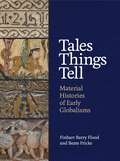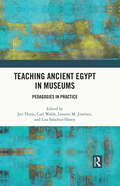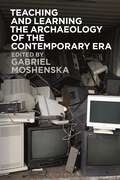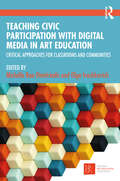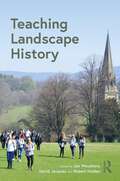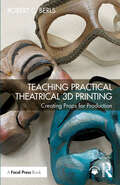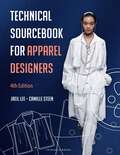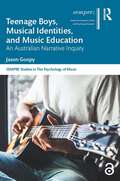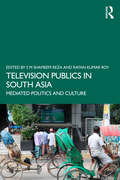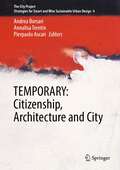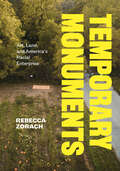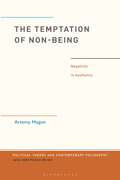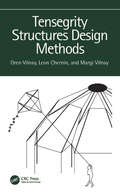- Table View
- List View
Tales Things Tell: Material Histories of Early Globalisms
by Finbarr Barry Flood Beate FrickeNew perspectives on early globalisms from objects and imagesTales Things Tell offers new perspectives on histories of connectivity between Africa, Asia, and Europe in the period before the Mongol conquests of the thirteenth century. Reflected in objects and materials whose circulation and reception defined aesthetic, economic, and technological networks that existed outside established political and sectarian boundaries, many of these histories are not documented in the written sources on which historians usually rely. Tales Things Tell charts bold new directions in art history, making a compelling case for the archival value of mobile artifacts and images in reconstructing the past.In this beautifully illustrated book, Finbarr Barry Flood and Beate Fricke present six illuminating case studies from the sixth to the thirteenth centuries to show how portable objects mediated the mobility of concepts, iconographies, and techniques. The case studies range from metalwork to stone reliefs, manuscript paintings, and objects using natural materials such as coconut and rock crystal. Whether as booty, commodities, gifts, or souvenirs, many of the objects discussed in Tales Things Tell functioned as sources of aesthetic, iconographic, or technical knowledge in the lands in which they came to rest. Remapping the histories of exchange between medieval Islam and Christendom, from Europe to the Indian Ocean, Tales Things Tell ventures beyond standard narratives drawn from written archival records to demonstrate the value of objects and images as documents of early globalisms.
Tales Things Tell: Material Histories of Early Globalisms
by Finbarr Barry Flood Beate FrickeNew perspectives on early globalisms from objects and imagesTales Things Tell offers new perspectives on histories of connectivity between Africa, Asia, and Europe in the period before the Mongol conquests of the thirteenth century. Reflected in objects and materials whose circulation and reception defined aesthetic, economic, and technological networks that existed outside established political and sectarian boundaries, many of these histories are not documented in the written sources on which historians usually rely. Tales Things Tell charts bold new directions in art history, making a compelling case for the archival value of mobile artifacts and images in reconstructing the past.In this beautifully illustrated book, Finbarr Barry Flood and Beate Fricke present six illuminating case studies from the sixth to the thirteenth centuries to show how portable objects mediated the mobility of concepts, iconographies, and techniques. The case studies range from metalwork to stone reliefs, manuscript paintings, and objects using natural materials such as coconut and rock crystal. Whether as booty, commodities, gifts, or souvenirs, many of the objects discussed in Tales Things Tell functioned as sources of aesthetic, iconographic, or technical knowledge in the lands in which they came to rest. Remapping the histories of exchange between medieval Islam and Christendom, from Europe to the Indian Ocean, Tales Things Tell ventures beyond standard narratives drawn from written archival records to demonstrate the value of objects and images as documents of early globalisms.
Teaching Ancient Egypt in Museums: Pedagogies in Practice
by Jen Thum Carl Walsh Lissette M. Jiménez Lisa Saladino HaneyTeaching Ancient Egypt in Museums: Pedagogies in Practice explores what best practices in museum pedagogy look like when working with ancient Egyptian material culture. The contributions within the volume reflect the breadth and collaborative nature of museum learning. They are written by Egyptologists, teachers, curators, museum educators, artists, and community partners working in a variety of institutions around the world—from public, children’s, and university museums, to classrooms and the virtual environment—who bring a broad scope of expertise to the conversation and offer inspiration for tackling a diverse range of challenges. Contributors foreground their first-hand experiences, pedagogical justifications, and reflective teaching practices, offering practical examples of ethical and equitable teaching with ancient Egyptian artifacts. Teaching Ancient Egypt in Museums serves as a resource for teaching with Egyptian collections at any museum, and at any level. It will also be of great interest to academics and students who are engaged in the study of museums, ancient Egypt, anthropology, and education.
Teaching Ancient Egypt in Museums: Pedagogies in Practice
Teaching Ancient Egypt in Museums: Pedagogies in Practice explores what best practices in museum pedagogy look like when working with ancient Egyptian material culture. The contributions within the volume reflect the breadth and collaborative nature of museum learning. They are written by Egyptologists, teachers, curators, museum educators, artists, and community partners working in a variety of institutions around the world—from public, children’s, and university museums, to classrooms and the virtual environment—who bring a broad scope of expertise to the conversation and offer inspiration for tackling a diverse range of challenges. Contributors foreground their first-hand experiences, pedagogical justifications, and reflective teaching practices, offering practical examples of ethical and equitable teaching with ancient Egyptian artifacts. Teaching Ancient Egypt in Museums serves as a resource for teaching with Egyptian collections at any museum, and at any level. It will also be of great interest to academics and students who are engaged in the study of museums, ancient Egypt, anthropology, and education.
Teaching and Learning the Archaeology of the Contemporary Era
by Gabriel MoshenskaThe tools and techniques of archaeology were designed for the study of past people and societies, but for more than a century a growing number of archaeologists have turned these same tools to the study of the modern world. This book offers an overview of these pioneering practices through a specifically pedagogical lens, fostering an appreciation of the diversity and distinctiveness of contemporary archaeology and providing an evidence base for course proposals and curriculum design.Although research in the field is well established and vibrant, making critical contributions to wider debates around issues such as homelessness, migration and the refugee crisis, and legacies of war and conflict, the teaching of contemporary archaeology in universities has until recently been relatively limited in comparison. This selection of carefully curated case studies from as far afield as Orkney, Iran and the USA is intended as a resource and an inspiration for both teachers and students, presenting a set of tools and practices to borrow, modify and apply in new contexts. It demonstrates how interdisciplinarity, practical work and radical pedagogies are of value not only for archaeology, but also for fields such as history, geography and anthropology, and suggests new ways in which we can examine our 20th- and 21st-century existence and shape our collective future.
Teaching Architecture: The New Age of Digital Design (Routledge Focus on Design Pedagogy)
In the post-COVID era, understanding the profound impact of digital technologies on design pedagogy is crucial. This book delves into experimental design education, showcasing projects utilising technology to transform creative and analytical processes.Emphasising the potential for digital-era technologies to create novel educational opportunities, the book addresses recent global events and their role in minimising educational disruptions in the evolving hybrid educational landscape. Each chapter offers case studies exploring digital technology's influence across architectural education, spanning interior design, urban planning, parametric digital design, architectural conservation, and design analysis. Contributors envision the hybrid virtual design studio’s future and discuss the collaborative role of digital technologies in urban design projects. The book analyses contemporary parametric design processes and machine learning through innovative historical case studies, examining new technologies in architectural conservation.With case studies from diverse locations, including South Africa, Turkey, the UK, and the United States, the book provides a global perspective on the influences and potential futures of digital technologies in architecture. Essential for those interested in the future of spatial design education, this book illuminates the pivotal role of technology in shaping its trajectory.
Teaching Architecture: The New Age of Digital Design (Routledge Focus on Design Pedagogy)
by Sadiyah GeyerIn the post-COVID era, understanding the profound impact of digital technologies on design pedagogy is crucial. This book delves into experimental design education, showcasing projects utilising technology to transform creative and analytical processes.Emphasising the potential for digital-era technologies to create novel educational opportunities, the book addresses recent global events and their role in minimising educational disruptions in the evolving hybrid educational landscape. Each chapter offers case studies exploring digital technology's influence across architectural education, spanning interior design, urban planning, parametric digital design, architectural conservation, and design analysis. Contributors envision the hybrid virtual design studio’s future and discuss the collaborative role of digital technologies in urban design projects. The book analyses contemporary parametric design processes and machine learning through innovative historical case studies, examining new technologies in architectural conservation.With case studies from diverse locations, including South Africa, Turkey, the UK, and the United States, the book provides a global perspective on the influences and potential futures of digital technologies in architecture. Essential for those interested in the future of spatial design education, this book illuminates the pivotal role of technology in shaping its trajectory.
Teaching Civic Participation with Digital Media in Art Education: Critical Approaches for Classrooms and Communities
by Michelle Bae-Dimitriadis Olga IvashkevichThis anthology shares educational practices to engage young people in critical digital media consumption and production. Comprehensive frameworks and teaching guidance enable educators to empower students to use digital technologies to respond to the social, political, economic, and other critical issues in their real-life and online communities. Section I of the book explores philosophical and conceptual approaches to teaching civic participation via digital media and technologies in various educational settings, Section II focuses on the participatory civic approaches in K-16 art education classrooms, and Section III outlines these approaches for arts-based community settings (after school programs, camps, online sites). Throughout, authors reference different technologies – video, digital collage, glitch, game design, mobile applications, virtual reality, and social media – and offer in-depth discussions of pedagogical processes and exemplary curriculum projects. Building on National (NAEA) and State Media Arts Standards, the educational practices outlined facilitate students’ media literacy skills and digital citizenship awareness in the art classroom and provide a solid foundation for teaching civic-minded media making. Ideal for art and media educators within preservice and higher education spaces, this book equips readers to prepare their students to be thoughtful and critical producers of their own media that can effectively advocate for social change.
Teaching Civic Participation with Digital Media in Art Education: Critical Approaches for Classrooms and Communities
by Michelle Bae-Dimitriadis Olga IvashkevichThis anthology shares educational practices to engage young people in critical digital media consumption and production. Comprehensive frameworks and teaching guidance enable educators to empower students to use digital technologies to respond to the social, political, economic, and other critical issues in their real-life and online communities. Section I of the book explores philosophical and conceptual approaches to teaching civic participation via digital media and technologies in various educational settings, Section II focuses on the participatory civic approaches in K-16 art education classrooms, and Section III outlines these approaches for arts-based community settings (after school programs, camps, online sites). Throughout, authors reference different technologies – video, digital collage, glitch, game design, mobile applications, virtual reality, and social media – and offer in-depth discussions of pedagogical processes and exemplary curriculum projects. Building on National (NAEA) and State Media Arts Standards, the educational practices outlined facilitate students’ media literacy skills and digital citizenship awareness in the art classroom and provide a solid foundation for teaching civic-minded media making. Ideal for art and media educators within preservice and higher education spaces, this book equips readers to prepare their students to be thoughtful and critical producers of their own media that can effectively advocate for social change.
Teaching Labor History in Art and Design: Capitalism and the Creative Industries (Routledge Studies in Education, Neoliberalism, and Marxism)
by Kyunghee Pyun Vincent G. QuanDrawing from American history, fashion design, history of luxury, visual culture, museum studies, and women’s history, among others, this book explores the challenges, rewards and benefits of teaching business and the labor history of art and design professions to those in higher education.Recognizing that artists and designers are no longer just creatives, but bosses, employees, members of professional associations, and citizens of nations that encourage and restrain their creative work in various ways, the book identifies a crucial need for art and design students to be taught the intricacies of these other roles, as well as how to navigate or challenge them. This empirically driven study features case studies in various pedagogical contexts, including museum exhibitions, group projects, lesson plans, discussion topics, and long-term assignments. The chapters also explore how the roles of designing and making became separated, how new technologies and the rise of mass production affected creative careers, the shifts back and forth between direct employment and freelancing, and the evolution of government interventions in creative fields.With a diverse and experienced range of contributors, and providing a unique set of conceptual tools to interpret, cope with, and react to the ever-changing conditions of capitalism, this volume will appeal to educators and researchers across education, history, art history, and sociology, with interests in experiential learning, capitalism, equity, social justice and neoliberalism.
Teaching Labor History in Art and Design: Capitalism and the Creative Industries (Routledge Studies in Education, Neoliberalism, and Marxism)
Drawing from American history, fashion design, history of luxury, visual culture, museum studies, and women’s history, among others, this book explores the challenges, rewards and benefits of teaching business and the labor history of art and design professions to those in higher education.Recognizing that artists and designers are no longer just creatives, but bosses, employees, members of professional associations, and citizens of nations that encourage and restrain their creative work in various ways, the book identifies a crucial need for art and design students to be taught the intricacies of these other roles, as well as how to navigate or challenge them. This empirically driven study features case studies in various pedagogical contexts, including museum exhibitions, group projects, lesson plans, discussion topics, and long-term assignments. The chapters also explore how the roles of designing and making became separated, how new technologies and the rise of mass production affected creative careers, the shifts back and forth between direct employment and freelancing, and the evolution of government interventions in creative fields.With a diverse and experienced range of contributors, and providing a unique set of conceptual tools to interpret, cope with, and react to the ever-changing conditions of capitalism, this volume will appeal to educators and researchers across education, history, art history, and sociology, with interests in experiential learning, capitalism, equity, social justice and neoliberalism.
Teaching Landscape History
Landscape history is changing in content and style to address the issues of today. Experienced teachers and authors on the history of gardens and landscapes come together in this new volume to share ideas on the future of teaching history in departments of landscape architecture, archaeology, geography and allied subjects. Design history remains important, but this volume brings to the fore the increasing importance of environmental history, economic history, landscape history, cultural landscapes, environmental justice and decolonisation, ideas of sustainability and climate change amelioration, which may all be useful in serving the needs of a widening range of students in an increasingly complex world. The main themes include: what history should we narrate in the education of landscape architects? how can we recognise counter-narratives and our own bias? how should we engage the students in the history of their chosen profession? how can designers and researchers be persuaded of the relevance of history teaching to theory and practice? and what resources do we need to develop teaching of landscape histories? This book will be of interest to anyone teaching courses on landscape architecture, urban design, horticulture, garden design, architectural history, cultural geography and more.
Teaching Landscape History
by Jan Woudstra David JacquesLandscape history is changing in content and style to address the issues of today. Experienced teachers and authors on the history of gardens and landscapes come together in this new volume to share ideas on the future of teaching history in departments of landscape architecture, archaeology, geography and allied subjects. Design history remains important, but this volume brings to the fore the increasing importance of environmental history, economic history, landscape history, cultural landscapes, environmental justice and decolonisation, ideas of sustainability and climate change amelioration, which may all be useful in serving the needs of a widening range of students in an increasingly complex world. The main themes include: what history should we narrate in the education of landscape architects? how can we recognise counter-narratives and our own bias? how should we engage the students in the history of their chosen profession? how can designers and researchers be persuaded of the relevance of history teaching to theory and practice? and what resources do we need to develop teaching of landscape histories? This book will be of interest to anyone teaching courses on landscape architecture, urban design, horticulture, garden design, architectural history, cultural geography and more.
Teaching Practical Theatrical 3D Printing: Creating Props for Production
by Robert C. BerlsTeaching Practical Theatrical 3D Printing: Creating Props for Production is a cohesive and practical guide for instructors teaching 3D printing techniques in stagecraft, costume and props courses.Written for the instructor, this book uses non-technical language to explain 3D printers, their workflows and products. Coverage includes the ins and outs of multiple filaments, pros and cons of different types of printers, shop or laboratory setup and safety concerns. The book features lesson plans, rubrics and class-tested sample student projects from design to finished product that highlight learning objectives and methodologies, as well as software and hardware usage explanations and common problems that can occur within design and printing. Step-by-step instructions are included for many types of projects, including fake noses, candlestick phones, buttons, 3D scans, historical recreations and linear actuators. The book also contains examples of poor, average and excellent work with grading explanations and guidance on how to help the student move to the next level with their projects. Chapter objectives, chapter summaries, checklists and reflection points facilitate an instructor in gaining confidence with 3D printers and incorporating their use in the classroom.Teaching Practical Theatrical 3D Printing is an excellent resource for instructors of Props and Costume Design and Construction courses that are interested in using state of the art tools and technology for theatre production.Fully editable files for every object featured in the book are available at www.routledge.com/9781032453279, allowing readers to jump-start their projects and giving them the flexibility to change and redesign the items to best fit their needs.
Teaching Practical Theatrical 3D Printing: Creating Props for Production
by Robert C. BerlsTeaching Practical Theatrical 3D Printing: Creating Props for Production is a cohesive and practical guide for instructors teaching 3D printing techniques in stagecraft, costume and props courses.Written for the instructor, this book uses non-technical language to explain 3D printers, their workflows and products. Coverage includes the ins and outs of multiple filaments, pros and cons of different types of printers, shop or laboratory setup and safety concerns. The book features lesson plans, rubrics and class-tested sample student projects from design to finished product that highlight learning objectives and methodologies, as well as software and hardware usage explanations and common problems that can occur within design and printing. Step-by-step instructions are included for many types of projects, including fake noses, candlestick phones, buttons, 3D scans, historical recreations and linear actuators. The book also contains examples of poor, average and excellent work with grading explanations and guidance on how to help the student move to the next level with their projects. Chapter objectives, chapter summaries, checklists and reflection points facilitate an instructor in gaining confidence with 3D printers and incorporating their use in the classroom.Teaching Practical Theatrical 3D Printing is an excellent resource for instructors of Props and Costume Design and Construction courses that are interested in using state of the art tools and technology for theatre production.Fully editable files for every object featured in the book are available at www.routledge.com/9781032453279, allowing readers to jump-start their projects and giving them the flexibility to change and redesign the items to best fit their needs.
Technical Sourcebook for Apparel Designers: - with STUDIO
by Jaeil Lee Camille SteenLearn technical design processes and industry standards, such as ASTM and ISO, for apparel production and manufacturing practices. With more than 1,200 images and technical packages for 12 apparel products, the book explains topics like fabric selection, finding seasonal fashion trends, garment construction, and fit evaluation, all so you can cost-effectively meet consumer needs. You'll learn about product categories including women's wear, menswear, and knitwear, as well as how to create a cost sheet and manage product data, to help you develop specification sheets and technical packages for specific markets. The 4th edition has been revised to include the use of sustainable materials, entrepreneurship and the job market, buying seasons as affected by the Covid-19 pandemic and supply chain, sourcing considerations, sizing and fit tips for diverse body types, and more. New to this Edition· Includes new information on sustainability and sourcing · Discusses changes in buying seasons as affected by the Covid-19 pandemic· Delves into the job market, job roles, and entrepreneurship · Updated to include sizing and fit tips for diverse body types STUDIO Features Include· Study smarter with self-quizzes featuring scored results and personalized study tips· Review concepts with flashcards of terms and definitionsInstructor Resources· Instructor's Guide to help integrate the text into your classroom· PowerPoint slides for every chapter
Teenage Boys, Musical Identities, and Music Education: An Australian Narrative Inquiry (ISSN)
by Jason GoopyMusic is a powerful process and resource that can shape and support who we are and wish to be. The interaction between musical identities and learning music highlights school music education’s potential contributions and responsibilities, especially in supporting young people’s mental health and well-being. Through the distinctive stories and drawings of Aaron, Blake, Conor, Elijah, Michael, and Tyler, this book reveals the musical identities of teenage boys in their final year of study at an Australian boys’ school.This text serves as an interface between music, education, and psychology using narrative inquiry. Previous research in music education often seeks to generalise boys, whereas this study recognises and celebrates the diverse individual voices of students where music plays a significant role in their lives. Adolescent boys’ musical identities are examined using the theories of identity work and possible selves, and their underlying music values and uses are considered important guiding principles and motivating goals in their identity construction. A teaching and learning framework to shape and support multiple musical identities in senior secondary class music is presented.The relatable and personal stories in this book will appeal to a broad readership, including music teachers, teacher educators, researchers, and readers interested in the role of music in our lives. Creative and arts-based research methods, including narrative inquiry and innovative draw and tell interviews, will be particularly relevant for research method courses and postgraduate research students.
Teenage Boys, Musical Identities, and Music Education: An Australian Narrative Inquiry (ISSN)
by Jason GoopyMusic is a powerful process and resource that can shape and support who we are and wish to be. The interaction between musical identities and learning music highlights school music education’s potential contributions and responsibilities, especially in supporting young people’s mental health and well-being. Through the distinctive stories and drawings of Aaron, Blake, Conor, Elijah, Michael, and Tyler, this book reveals the musical identities of teenage boys in their final year of study at an Australian boys’ school.This text serves as an interface between music, education, and psychology using narrative inquiry. Previous research in music education often seeks to generalise boys, whereas this study recognises and celebrates the diverse individual voices of students where music plays a significant role in their lives. Adolescent boys’ musical identities are examined using the theories of identity work and possible selves, and their underlying music values and uses are considered important guiding principles and motivating goals in their identity construction. A teaching and learning framework to shape and support multiple musical identities in senior secondary class music is presented.The relatable and personal stories in this book will appeal to a broad readership, including music teachers, teacher educators, researchers, and readers interested in the role of music in our lives. Creative and arts-based research methods, including narrative inquiry and innovative draw and tell interviews, will be particularly relevant for research method courses and postgraduate research students.
Television Publics in South Asia: Mediated Politics and Culture
by S.M. Shameem Reza and Ratan Kumar RoyTelevision has a prime role to play in the formation of discursive domains in the everyday life of South Asian publics. This book explores various television media practices, social processes, mediated political experiences and everyday cultural compositions from Afghanistan, Bangladesh, India, Nepal, Pakistan and Sri Lanka. With the help of country specific case studies, it captures broad range of themes which foreground the publics and their real-life experiences of television in the region. The essays in this book discuss gendered television spaces; women seeking solace from television in pandemic; the taboo in digital tv dramas; television viewership and localizing publics; changing viewership from television to OTT; news and public perception of death; re-defining ‘the national’; theatrical television; and post truth television news, among other key issues. Rich in ethnographic case studies, this volume will be a useful resource for scholars and researchers of media and communication studies, journalism, digital media, South Asian studies, cultural studies, sociology and social anthropology.
Television Publics in South Asia: Mediated Politics and Culture
Television has a prime role to play in the formation of discursive domains in the everyday life of South Asian publics. This book explores various television media practices, social processes, mediated political experiences and everyday cultural compositions from Afghanistan, Bangladesh, India, Nepal, Pakistan and Sri Lanka. With the help of country specific case studies, it captures broad range of themes which foreground the publics and their real-life experiences of television in the region. The essays in this book discuss gendered television spaces; women seeking solace from television in pandemic; the taboo in digital tv dramas; television viewership and localizing publics; changing viewership from television to OTT; news and public perception of death; re-defining ‘the national’; theatrical television; and post truth television news, among other key issues. Rich in ethnographic case studies, this volume will be a useful resource for scholars and researchers of media and communication studies, journalism, digital media, South Asian studies, cultural studies, sociology and social anthropology.
Temporäre Architekturen: Die Architektengruppe »raumlaborberlin« und das Theaterprojekt »Eichbaumoper« (Architekturen #74)
by Katrin KlitzkeWie können zeitgenössische temporäre Architekturen partizipativ gestaltet werden? Katrin Klitzke beantwortet diese Frage exemplarisch anhand einer Analyse des Theaterprojekts »Eichbaumoper« der Architektengruppe »raumlaborberlin«. Die »Eichbaumoper«, welche in Kooperation mit drei Theaterhäusern entstand, sollte durch die Einbeziehung kommunaler Jugendarbeit und eines öffentlich angelegten Prozesses des Bauens und Gestaltens als eine architektonische Intervention realisiert werden. Inwieweit Architekt*innen die Aspekte des Partizipativen und Politischen umsetzten und ihre Architekturen am globalisierten Markt positionierten, steht im Zentrum des Interesses. Es wird deutlich: Temporäre Räume lassen sich gestalten und planen - dabei sind Reibungen und Interessenskonflikte immanent.
TEMPORARY: Citizenship, Architecture and City (The City Project #4)
by Andrea Borsari Annalisa Trentin Pierpaolo AscariThis book offers a comprehensive overview of forces shaping urban renewal and the sustainable and inclusive transformation of contemporary cities. It discusses temporariness and uncertainty of citizenship, participation, and inclusion, as well as the energy and digital transformation, merging different perspectives, such as the social, philosophical, economic, and architectural ones. Based on revised and extended contributions to the International Congress “TEMPORARY: Citizenship, Architecture and City", held virtually on November 20-21, 2022, from the University of Bologna, this book offers extensive information and a thought-provoking reading to researchers in architecture, anthropology, social and environmental policy, as well as to professionals and policy makers involved in planning the city of the future.
Temporary Monuments: Art, Land, and America's Racial Enterprise
by Rebecca ZorachHow art played a central role in the design of America’s racial enterprise—and how contemporary artists resist it. Art has long played a key role in constructing how people understand and imagine America. Starting with contemporary controversies over public monuments in the United States, Rebecca Zorach carefully examines the place of art in the occupation of land and the upholding of White power in the US, arguing that it has been central to the design of America’s racial enterprise. Confronting closely held assumptions of art history, Zorach looks to the intersections of art, nature, race, and place, working through a series of symbolic spaces—the museum, the wild, islands, gardens, home, and walls and borders—to open and extend conversations on the political implications of art and design. Against the backdrop of central moments in American art, from the founding of early museums to the ascendancy of abstract expressionism, Zorach shows how contemporary artists—including Dawoud Bey, Theaster Gates, Maria Gaspar, Kerry James Marshall, Alan Michelson, Dylan Miner, Postcommodity, Cauleen Smith, and Amanda Williams—have mined the relationship between environment and social justice, creating works that investigate and interrupt White supremacist, carceral, and environmentally toxic worlds. The book also draws on poetry, creative nonfiction, hip-hop videos, and Disney films to illuminate crucial topics in art history, from the racial politics of abstraction to the origins of museums and the formation of canons.
The Temptation of Non-Being: Negativity in Aesthetics (Political Theory and Contemporary Philosophy)
by Dr. Artemy MagunWhy do we enjoy artworks that depict disasters and suffering? Is this a hangover from the Modernist impulse to break the rules of harmony? Is there actually a proper way to perform negativity in art without resorting to nihilism? The Temptation of Non-Being uses these fundamental questions to paint a picture of contemporary art as beset by an outbreak of the negative, and to construct a new theory of art as a medium of complex negativity. The negative in art is explained not as a simple negation or destruction, but as a multifaceted, polymorphous structure with a vast range of strategies and techniques from parody and pastiche to defamiliarization and non-resemblance. Charting the depth of these negative practices, Artemy Magun shows how they become progressively more complex and explicit, illustrating them with interdisciplinary examples from Lars von Trier, Jacek Malczewski, Andrei Platonov and Fyodor Dostoyevsky. At the heart of this layered, nested structure lies an understanding of Modern aesthetics that helps to answer even more questions: how can the testing, probing nature of art lead to this preoccupation with the negative? Why does this negativity emerge in the first place? What can it tell us about art itself and how it functions in society? This is an erudite and provocative analysis that enriches the ongoing evaluation of both 'high' and 'low' art.
Tensegrity Structures Design Methods
by Oren Vilnay Leon Chernin Margi VilnayTensegrity structures are pre-stressed systems of cables and bars in which no bar is connected to the other and the structure has no continuous rigid skeleton. This general introduction presents an original general method for the design of tensegrity structures, the first configurations of which were found by trial and error. The book begins with two-dimensional tensegrity structures, particularly tensegrity nets, tensegrity chains, tensegrity rings and tensegrity arches. These are then developed to original configurations of spatial tensegrity structures such as tensegrity slabs, primitive spatial tensegrity arches, and primitive tensegrity domes, as well as more elaborate spatial tensegrity structures such as tensegrity cylindrical shells, slim tensegrity domes, tensegrity vaults, and tensegrity caps. Presents a robust new approach to the design of tensegrity structures Extends tensegrity structures to new three-dimensional configurations Tensegrity Structures Design Methods suits structural, civil, and mechanical engineers and architects, as well as graduate students. Oren Vilnay is Professor Emeritus and was founder and head of the Department of Structural Engineering at Ben Gurion University Israel. He is also former head of the Structural Engineering Section at Technion—IsraelInstitute of Technology. Leon Chernin is Lecturer at the University of Dundee. He was granted a PhD in Structural Engineering from the Technion—Israel Institute of Technology. His research activities encompass both physical testing and numericalmodelling. Margi Vilnay is Senior Lecturer at the University of Dundee. She was granted a PhD in Structural Engineering from Heriot-Watt University. She is a chartered member of the Institution of Civil Engineers and the first woman to be elected Vice-Chair of COMEC (Council of Military Education Committees).
